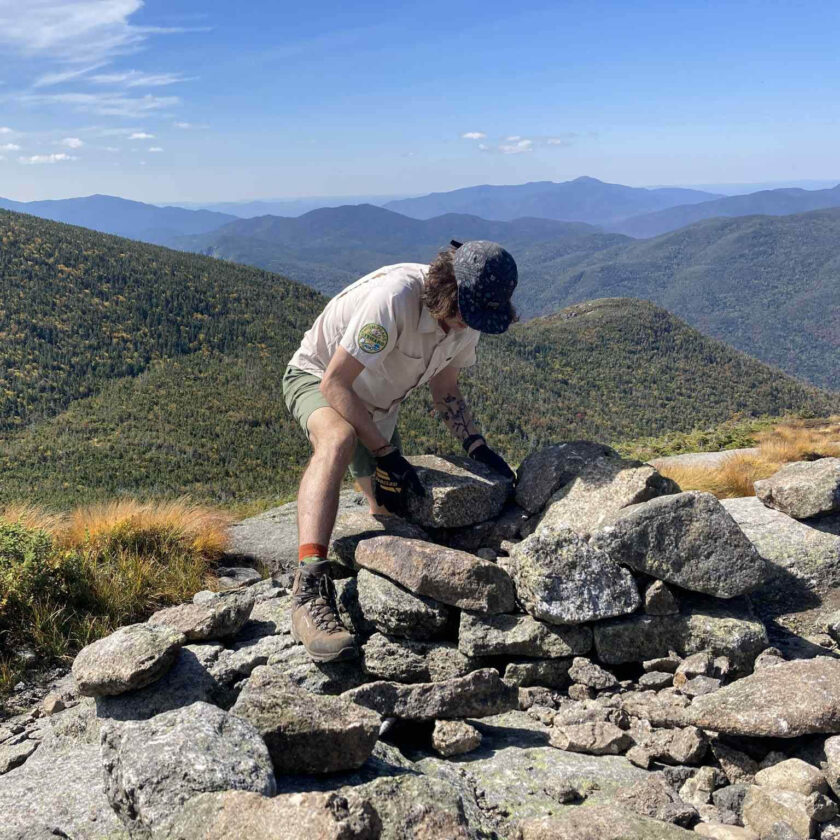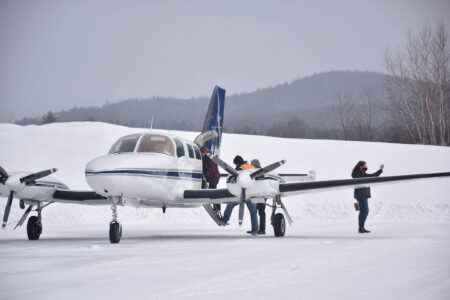Wright Peak summit cairns knocked down
ADK to rebuild starting this week

ADK Stewardship Manager Liam Ebner begins rebuilding a cairn on Wright Peak on Tuesday. (Provided photo — Adirondack Mountain Club)
NORTH ELBA — Eleven of 12 cairns atop Wright Peak were deliberately knocked down on Monday.
Cairns are rock structures that are used for navigational purposes above the treeline, where trail marker discs aren’t feasible. They are one of two primary navigational sources in the Adirondacks’ alpine zones, along with yellow blazes that are painted on to rockface to mark the trails.
Cairns — due to their large standing structure — are especially important during the winter or periods of poor visibility, when the yellow paint blazes are to difficult or impossible to spot. They are built by professional trail crews and summit stewards and are designated by state Department of Environmental Conservation land managers for their specific spots, according to Kayla White, Adirondack Mountain Club’s Stewardship Director.
White oversees ADK’s summit stewardship program, which aims to educate hikers about the importance of protecting alpine environments. In addition to helping hikers navigate the trail, cairns serve a distinctly important purpose of keeping hikers away from where they’re not supposed to step. Staying on the designated trails takes on an outsized importance in Adirondack alpine zones, which are especially fragile ecosystems. When trampled, it doesn’t take much to debilitate the often small vegetation, which is also much slower to recover than lower-elevation environments.
“It helps keep people on trail and off the really fragile alpine vegetation that we have and really thin soils that are really prone to erosion,” she said. “That’s why having cairns is really, really helpful — just keeping people on trail and having them walk on the bare rock.”
It’s unknown who knocked the structures over, and White said it’s probably impossible to know for sure what the motivation was — but it likely was one of two things: mischief or a misinformed and false belief that the cairns were unlawful alterations to the natural environment. White said it’s disappointing that someone caused such extensive damage possibly based on either malintent or misinformation.
A large part of White’s job is educating the public, and she understands that everyone comes to the trailhead with varying levels of experience and background knowledge. ADK has signs placed at the trailheads informing people about the cairn’s purpose, the fact that they are legally permitted to stand and should not be tampered with.
White added that rebuilding the cairns is not a quick or easy task. Many of the ones on Wright were taller than most people, and were so large that it was impossible to fully wrap one’s arms around them. Furthermore, the stones were very carefully placed against each other for a snug and durable fit. Repairing them is similar to building a stone wall, and building one well requires expertise working with stone that can take years to develop.
While all of the High Peak summits are prone to strong winds, Wright Peak is widely considered to be one of the windiest summits. Not only does this make cairns at its summit especially crucial in the winter — when winds can whip up snow and drastically reduce visibility — but it also means these cairns must be built to withstand extreme weather.
“A couple of them were built up there in 2007 and have lasted almost 20 years,” she said. “They were built so big. They were super, super solid and really, when you’re building a cairn, you want to make sure that it is this large structure that breaks against the skyline so it’s easier for your eye to see them. They were purposely built where they were and it is tough to navigate above treeline without them.”
At 4,580 feet, Wright Peak is one of the Adirondack 46 High Peaks and the 16th-tallest mountain in the state. Its bald summit and 360-degree views make it a popular hiking destination. White noted that when she and ADK Stewardship Manager Liam Ebner were up assessing and beginning to repair the damage on Tuesday, the lack of standing cairns was already causing people to get off trail.
“We noticed already people going off trail, having a tough time following the trail without those navigational markers in place,” she said.
Given the safety and environmental risks that come with not having cairns near Wright’s summit, White said ADK was mustering all of its trail stewards — who were scheduled to do a variety of other trail work throughout the High Peaks — to Wright Peak to rebuild. It’s a top priority and intensive work is slated to take place the rest of this week and next week. White said there’s no definitive timeline on how long it will take, and that ADK was in the process of designating specific rebuilding tasks based on their stewards’ varying levels of experience working with the stone.
“Because it is so tough to navigate without them, we just didn’t want to see continued damage occur up there because of this,” she said.
While it’s a necessary redirection of resources, White pointed out that pulling the stewards from important work that had been scheduled is an unfortunate secondary consequence of the damage — especially given that winter sets in quicker at the high summits, creating an already-limited work window for ADK personnel.
If someone is unsure of whether a rock structure in the wild is permitted, they should reach out to ADK or the DEC, who will be able to assess that with certainty and, if it is unlawful, remove it responsibly. White added that all of ADK’s work above treeline is discussed with and pre-approved by the DEC.
As an outdoors educator, White said she likes to differentiate the term cairns from rock stacks — the latter of which refers to the non-DEC-designated rock pile creations individuals decide to build on their own, perhaps in a stream bed or near a campsite.
“Cairns are navigational markers. They’re designated by the land manager. They’re meant to be there as a navigational tool,” she said. “A rock stack is … not made or authorized by the land manager. That’s a really big difference, and that’s why education is so important.”
These rogue rock piles can cause environmental damage — most notably in increased erosion when rocks are removed from the soil or disturb riparian habitat and stream flows, even if it’s at a micro level.
“There is an ecological cost to folks just randomly stacking rocks,” White said. “That confuses hikers and it’s very different than cairns.”
White said cairn destruction happens from time to time. She said what stands out about Wright Peak is how extensive the damage was. She said usually, it’s a couple of the cairns, whereas this time was almost every one on the trail to Wright. White speculated that the perpetrators simply did not see the one structure that they left standing — otherwise, that probably would have been destroyed too.
“These were built pretty bomb-proof in the sense that they were massive structures,” she said. “It took a lot of effort to destroy them.”
White said that hikers planning on heading to Wright Peak should take into account that until the cairns are rebuilt, the trail could be harder to navigate — especially during inclement weather. She said people can call ADK’s High Peaks Information Center at 518-523-3441 for the latest weather and trail conditions during its regular hours from 6 a.m. to 5 p.m. Mondays through Thursdays and 5 a.m. to 8 p.m. Fridays through Sundays. More information is also available on ADK’s website, adk.org.
White added that when hiking Wright Peak, people should not move any of the stone piles, whether they are standing or not, and look out for yellow paint blazes as a primary source of navigation in the alpine zone for now.
——
A previous version of the article included an incorrect number of cairns on Wright Peak.



